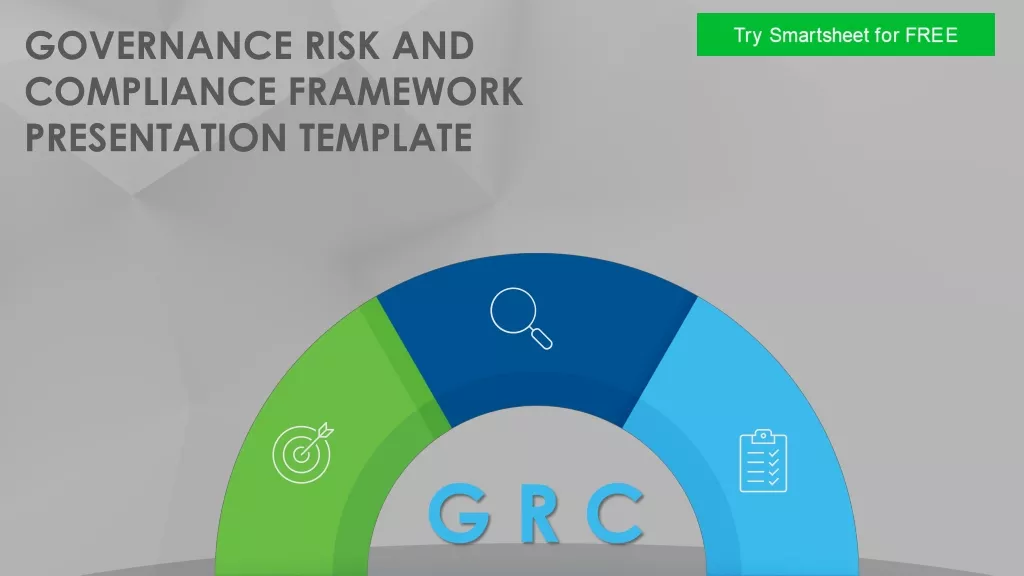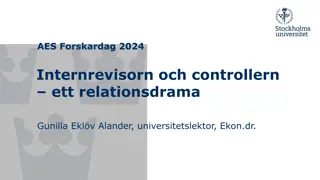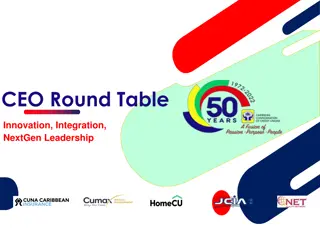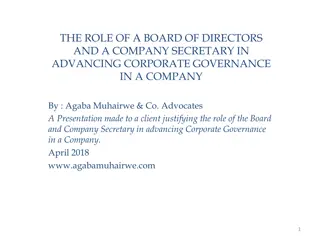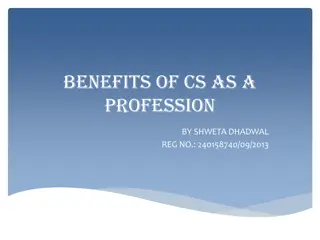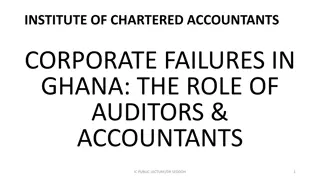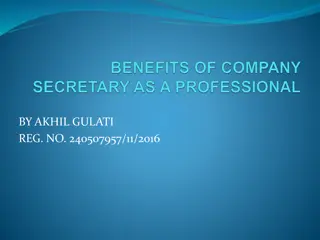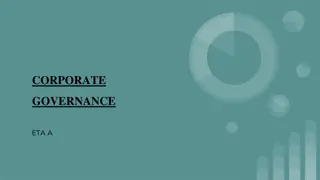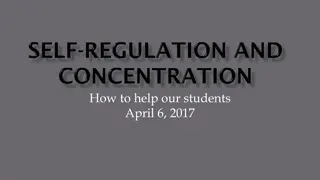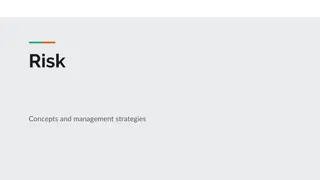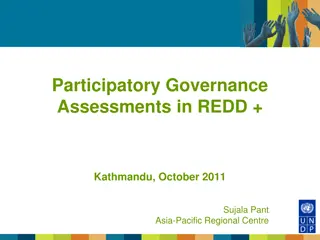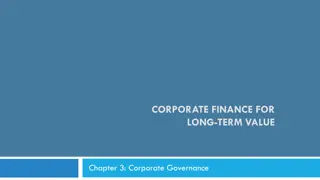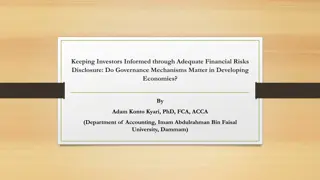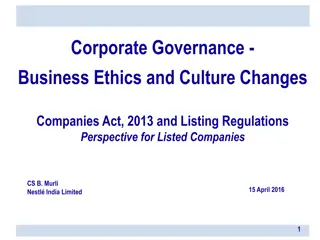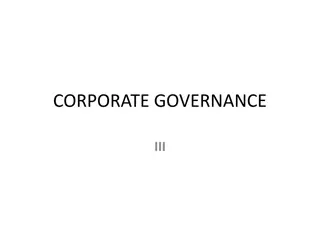Risk, Regulation, and Compliance in Corporate Governance
Explore the role of risk, regulation, and compliance in corporate governance through the insightful perspectives shared by Professor Tom Kirchmaier. Delve into key concepts such as risk waterfall, compliance as value creation, and the strategic decision-making of governance. Gain a deeper understanding of how these factors contribute to the functioning and success of organizations.
Download Presentation

Please find below an Image/Link to download the presentation.
The content on the website is provided AS IS for your information and personal use only. It may not be sold, licensed, or shared on other websites without obtaining consent from the author.If you encounter any issues during the download, it is possible that the publisher has removed the file from their server.
You are allowed to download the files provided on this website for personal or commercial use, subject to the condition that they are used lawfully. All files are the property of their respective owners.
The content on the website is provided AS IS for your information and personal use only. It may not be sold, licensed, or shared on other websites without obtaining consent from the author.
E N D
Presentation Transcript
Risk, Regulation, and Compliance (Part I) Prof Tom Kirchmaier Center for Corporate Governance, Copenhagen Business School Centre for Economic Performance, London School of Economics 16 January 2020 1
A word about myself Professor for Risk, Regulation, and Compliance at Copenhagen Business School (CCG) Member of the Centre for Economic Performance, London School of Economics (Crime Lab) Previously: Financial Markets Group, London School of Economics Interested in Boards, Banks, and Gender PhD: London School of Economics on the Economics of the Firm Empirical Economist (loves data) German by birth, European by heart 2
Disclosure Link 3
House Rule Chicago Style: Ask whatever, whenever (Let s have a nice debate) 4
Aim for Today To debate concepts on GRC & AML So you can ask the right questions I will not focus on individual regulation 5
Risk Waterfall Compliance often seen as a necessary evil, and one that does not add value Key in helping to reduce risk in complex systems Effective, and underappreciated, way of creating value in organisations Often the only way to be able to run complex operations Risk Regulation Compliance 6
Back to Basics Possibly obvious, but still important 7
Definitions Risk the quantitative assessment of (1) likelihood of unfavourable events occurring, and (2) likely loss resulting from it. Uncertainty the unquantifiable portion Compliance enforcement Governance making a strategic decision on how much risk a firm should take on (the boards role) 8
The Sources of Rent How do firms/banks make profits? Firms make calculated decisions on risk. Theoretically, in competitive markets with equal inputs and regulation, risk management is the key differentiator (outperforming the risk-reward relationship). 9
A Word on People Training Matters Economists trained to think in marginal benefits and costs/risks Lawyers trained to aim for zero risk / certainty 10
A Word on Risk Data Matters Financial organisations / banks find it terribly difficult to aggregate risk up in a meaningful way. The non-quantification of risk means overreporting to board (together with the general risk-aversion). Data and clear processes can help to manage financial and non- financial risk. 11
A Word on Boards The Role of Boards Boards set the strategic direction Boards set the risk appetite Boards set the principles Boards set the tone Boards don t manage 12
On Risk 13
Compliance is the Mirror of Risk A call to conceptually integrate thinking and process Understanding risk is a competitive advantage, if it is carried through by the organisation (compliance) Problems / Issues Risks Risks are potential future problems A risk should answer these 3 questions: What can/will go wrong? Why will it happen? Why is this risk a problem? Establish probability of occurrence and likely loss Identify mitigating actions Enables mandatory reporting and follow-up on correct level Enables integrated reporting with risk appetite and limits Problems/issues are hick ups in the daily operations and systems Problems/issues have occurred and need to be resolved Mitigation actions need to be identified and implemented Problems/issues should be analysed and used for input when identifying new potential risks Vs. 14
Risk Strategies How to deal with it ACCEPT MITIGATE AVOID 15
Risk Identification Data Matters Understanding where and how risks emerge in the business is key But how? Emerging risks are hard to spot, as one doesn t know where to look in a universe of possibilities Known and unknown unknowns Far too much data, and not enough information Expert judgment helpful but not unbiased, nor complete Good empirical work (Econometrics / ML) can help to identify patterns, early indicators, and to quantify a distribution of the risk We can analyse both financial and non-financial risk It requires a stringent collection and use of data throughout the organisation (bottom-up) 16
Operational Risk Level 1 Risks Insurance Risk Business Model Risk Credit Risk Market risk Liquidity Risk Model Risk ESG Risk Compliance Risk Counterparty Risk Products and services Wholesale Funding Risk FX Risk Key Partner Risk Default Risk Governance and internal processes Deposit Risk Interest Rate Risk Recovery Risk Unexpected risk to due changes in assumption: Funding Mismatch Risk Key Activity Risk Credit Spread Risk Process Risk Concentration Risk Changes in Consumer Expectations Level 2 Risks Poor quant. models Financial Crime IT Risk Intraday Risk Key Equity Risk Specialised Lending Portfolio Risk Longevity Reputational Risk Off-Balance Sheet Risk Resources Risk Climate Change Inflation Risk Market Abuse Volatility Conduct Risk Commodity Risk Prudential Reporting Climate Marketable Asset Risk Fintech Securitisation Risk Market Liquidity Risk (Regtech) Security Non-Marketable Asset Risk Shadow Banking Risk Data 17 Adapted from CBS / Nordea / Plesner Course on Risk Management and Compliance
Compliance is a Function of Risk (and risk is multi-dimensional) 19
Compliance efforts need to be proportional to risk Regulator is interested in process, not box-ticking 20
Compliance Function Purpose Monitor and assess effectiveness of methods and procedures to identify and mitigate risks Report the findings to the Executive, and the Board of Directors Requirements for compliance function: 1) is independent 2) no conflicts of interest 3) appoints staff responsible for compliance 4) bank allocates sufficient resources 5) staff has necessary competencies and knowledge to perform duties 6) staff has access to all relevant information 21
Compliance Compliance tied to Banking License, for others relatively new (MIFID I, 2007). Compliance costly Compliance function can get very big, with little direct value added Whistleblowing Non-compliance also costly Fines Reputational damage (naming and shaming) Trade-off between cost and benefits Interesting cases B737 Max BP (Deepwater Horizon) 22
Three Lines of Defence 1st Line of Defence 2nd Line of Defence 3rd Line of Defence Business Group Risk & Compliance Group Internal Audit It is accountable for identifying, mitigating and Internal audit is an independent and objective Designs the risk management frameworks reporting the risk status assurance activity designed to add value and Understands the regulatory environment and Promotes the right risk culture improve the operations implication Operates within the agreed risk appetite Focuses on operational auditing of the internal Provides Policies & Guidelines Works with the risk owners to ensure risks are control system Ensures risk management oversight by identified, assessed, mitigated, monitored and independent monitoring and controlling of the 1st reporting according to the agreed frameworks LoD Monitoring & Control Execution Assurance Adapted from CBS / Nordea / Plesner Course on Risk Management and Compliance. 23
Reporting Pyramid High-level description Illustration of the Governance Hierarchy 1 Final ratification of all material risk management decisions Approval of Group risk appetite Oversight of highest risk issues (e.g. regulatory issues) 1 Board Approval of all material decisions regarding the management of non-financial risks Oversight of key group metrics and high risk issues, including review of plans to close 2 2 Executive 3 Discussion of non-financial risk strategy and execution in the context of overall risk strategy Advisory role to CEO and Group Board Integrated Risk Reporting 3 Group Risk Committee 4 Ensures effective and consistent execution of non-financial risk activities across the 1 LoD through: - Oversight of 1 LoD non-financial risk metrics and high risk issues and risk appetite consumption - Decision-making power on significant 1 LoD non-financial risk issues - Sets mandates for Cross BA Sub- & Operational Forums 4 Operational Risk Committees 5 5 Determines common strategy for non-financial risk management across the Business Area / Country / topic Oversight of the execution of BA non-financial risk strategy, decisions and review of key BA risk metrics Set mandates for Business Units Sub-forums 2nd Line of Defence Forums 1st Line of Defence Forums Adapted from CBS / Nordea / Plesner Course on Risk Management and Compliance. 24
Digitalization and Workflow Humans are good making judgements, machines in performing routine tasks. But we waste humans on routine tasks in compliance. Rethink processes and workflows, optimise them, and then digitalise them. 25
Revisiting AML / CTF (Part II) Prof Tom Kirchmaier Center for Corporate Governance, Copenhagen Business School Centre for Economic Performance, London School of Economics 26
Aim for Today Understand causes of the AML system malfunctioning Discuss & develop concrete steps on how to improve it 27
Issues with AML Initiatives Large issue, as 1-2% of GDP might be illegal economic activities (Globally USD 1 trillion (of 80)). ML issue might be larger. Incredibly expensive for society Cumbersome for banks, their staff, customers, and intermediaries Very ineffectual We might just find 1% of ML payments, if at all Strong bias to detect the small, and unsophisticated criminals Very profitable for consultants, TR(Refinitiv), etc. Inefficient steady state? 28
An Example From Europol A payment processor for drug payments Collects cash from street dealers throughout Europe; around 1bn annually Counts it, launders it through European banking sector, and sends it back to the Americas as clean Fee: About 6-7%. Expected detection likelihood: 0% Origin: Lebanon, with possible links to Hezbollah 29
A Reminder Sources of funds, classified as ML 1. Proceeds of (Serious) Criminal Activity Drugs. Human Slavery. Child Sexual Exploitation. Racketeering. Fraud. Cyber & Organised Crime Real impact on society, and asset prices (property & businesses) Organised crime and jihadi groups increasingly intertwined (examples from Sweden and Denmark) 2. Embezzlement of State Funds, Tax Evasion, and Serious Corruption 3. Avoidance of Currency Controls (China) 4. [Terror Finance] 30
The Legal & Institutional Framework In need of restructuring 1. FATF (Born out of G7 in 1989): 40 rules Rules written by lawyers for lawyers; very difficult to operationalise Unclear how effective. In urgent need of a complement 2. Financial Investigation Units (FIUs) Very under-resourced, as political priorities are with classical policing High staff turnover, as Banks poach aggressively Staffed by police men / women, with good investigative skills Very short time window for investigation / decision on STRs 3. Banking Regulators Historically limited use of powers and resources (see EBA, and others) Branches vs Subsidiaries (remember AIG Banque USD 180 billion bailout) 31
The Legal & Institutional Framework In need of restructuring 4. The Executive Knee-jerk reactions: e.g. Prison sentences for Board Members A global problem in search of a national solution . Delegate up to EU level? No holistic approach to the issue at hand 5. FinTech The forgotten bad boy in the room? 32
On Data The application to AML 33
Data Infrastructure The Current Issues The data revolution has not yet arrived in the AML world Far too much work is done manually, which is expensive and cumbersome, and leads to inconsistent outcomes Detection algorithms focus on within account consistency, not across (very easy to circumvent) Algorithms lack an outcome variable (prosecution/conviction), and hence are trained to detect a small number of known cases -> key role for universities Substantial body of literature on SOC, but typically ethnographic, documentary, or biographic in nature, often picked up by the Media, and Hollywood. This leads to a popular conception that is based on anecdotes rather than empirical work (which might feed back to policy making) 34
Data Infrastructure The Current Issues II SARs / STRs Banks overreport, while possibly protecting their best clients Almost all SARs are not followed-up Decision time an issue The SARs data infrastructure is in urgent need of an overhaul - globally KYCs central to the functioning of banks (counterparty risk) Understand your customer. Important for AML, but even more so for the running of the bank Standard Chartered Dubai No standardised data interchange across borders, institutions, and banks 35
In Summary We fail in our objective Our institutional structure is not delivering Data and processes are inadequate on bank/fintech and supervisory level 36
What Next? 37
General Issue I In need of public debate AML will never be risk-free! (As is any business. Lawyers vs. Economists) We need to define - in a political process - the accepted level of risk society is prepared to take? 38
General Issue II The Nordics The Nordics have a beautiful culture of trust (to be protected)! The Nordics are unprepared to deal with aspects of globalisation The Nordics are very small population wise The Nordics are facing a big threat (jihadi) 39
Way Forward Work together, pool resources, and data! *across banks *across countries *across institutions1 1 (FIU, Supervisor, Police, Intelligence services, ) 40
Way Forward Standardise, Integrate, Automate 41
Way Forward Standardise, Integrate, Automate A Digitalisation Story, which will need to start with Processes, not Products 42
On Institutions Selected Reform Proposals 43
On Institutions The General We will need to rethink our decentralisation paradigm 44
On Institutions Proposal I Combine FIUs and supervisory bodies, here the Danish FSA, under one roof The FSA pays for all activities, including the FIU investigators who will work alongside and in close collaboration with the FSA staff The financial supervisor understands banks much better than a FIU ever can, has access to their data, should have the empirical skills, and is much better resourced than the Police Service Sovereign functions still with Police/FIU, but located within the supervisor s organisation Centralise on EU level into a new Supra-national body (French-Dutch Proposal) 45
On Institutions Proposal II: Standardise, Integrate, Automate across Nordics Standardise STR/SARs data collection across Nordics / Europe Integrate SARs data across Nordics / Europe (as part of the normal police information exchange) Organised Crime Group data across Nordics (if not yet done), and integrate with FIU system/data Current integration level of Intelligence data? Share (SARs) data for research purposes Sanctions list Automate Better algorithms, in part by: Counterparty check with OCGM (ideally offer as an API service to Banks [+/-]). Plausibility check via OpenCorporates / Experian / Pattern detection across countries, banks, etc. Empirical knowledge is in universities 46
On Institutions Proposal III Reorganised FSAs along clear lines of responsibilities, and without conflict of interest Regulatory, Policy,and Algorithms (pre-legislative work) Inspection(inspections into bank s compliance with regulation) Investigations (investigations under strengthened legal guarantees and legal controls, handed over from the Inspections Unit) Enforcement 47
On Data The application to AML 48
On Data The General Society will win the AML race on its ability to: collate, and analyse data very fast and cheap execute resulting actions fast and cheap (but here we will need a human at the end of process) => Standardise, Integrate, Automate 49
On Banks Proposal II: Standardise, Integrate, Automate across Nordics Standardise KYC data requirements (ideally just do it once) Transaction data (Value in that data, but London data pool not successful) Geographic information on the same level as open data (very promising!) Integrate KYC initiative for Nordics (currently only for commercial clients) Transaction data pool, and networks (there is value in it, if done well) Counter party information (with common rule book across Nordics) Organised Crime Group data across Nordics (if not yet done), and integrate with FIU system/data Pooling of SARs, and Geographic SARs information Counterparty check with OCGM (ideally offer as an API service to Banks [1/0]). Plausibility check via OpenCorporates / Experian / Sanctions list Automate Better algorithms, in part by tailoring algorithms to use cases (1-4) Allowing universities to contribute, and give access to outcome variables See above counter-party info requirements 50








